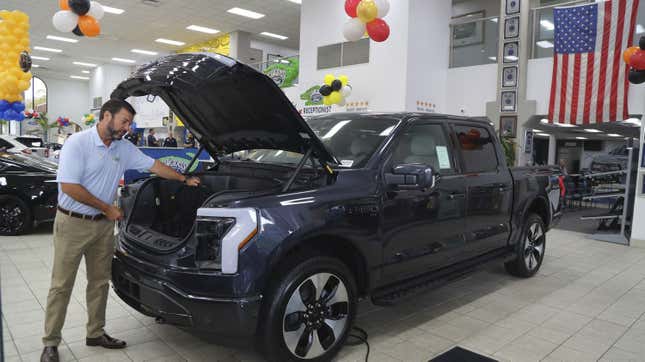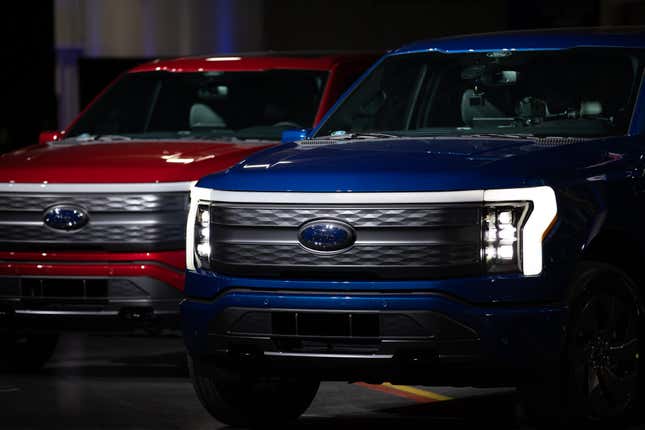
The latest guidelines regarding EV tax credits in the Inflation Reduction Act are finally available now that the U.S. Treasury Department published its overview of the subsidies. The new rules are reportedly going to make most EVs sold in the U.S. ineligible for tax credits, according to the New York Times, although the guidelines are subject to change pending a public comment period and what’s likely to be even more discussions between legislators in the U.S. and automakers.
In case you missed it:
- These Are the Cars From 25 Years Ago You Want to Own as Classics
- Consumer Reports’ 18 Most Satisfying New 2023 Vehicles to Own
- CEO Tim Kuniskis Explains How Dodge Is Handling Dealer Markups on Challenger Demon 170
The new rules go into effect on April 18, and these start by outlining household income, capped at $150,000 for individuals and $300,000 for married couples. Anyone or any couple making over those amounts is not eligible for any EV tax credits at all, nor are any “new clean vehicles” over a certain MSRP: Vans, SUVs and pickup trucks cannot exceed $80,000, while all others (presumably, sedans and wagons) can’t cost over $55,000.
But those are just the base requirements, because it gets way more complicated from there. Prior to the latest rules outlined by the IRA, all EVs sold in the U.S. were eligible for federal and state subsidies — up to a certain number of vehicles sold by carmakers, that is. This arrangement was, more or less, OK before all these fancy new EVs started showing up, prompting the need for a revision to tax credits that had all but dried up by the time legacy automakers decided to take on newcomers like Tesla and Rivian.

The advent of EVs from Ford, General Motors, Stellantis, Volkswagen and Toyota, just to name a few, coincided with supply chain disruptions that made U.S. legislators worry America was becoming too dependent on China for the electrification of its public and private auto fleet. So, Senator Joe Manchin introduced certain provisions meant to move the EV supply chain back to the U.S., or at least to countries with standing free trade agreements with America. And this yielded what many automakers said were unnecessarily strict rules.
The back and forth between the industry and the state is coming to a close soon, (for now, at least) and the latest rules in the IRA have broken down eligibility through the next few years into two different subsidies relating to the sourcing of critical minerals used in an EV battery, and the country of battery assembly.
Both subsidies are worth up to $3,750 each, and they can combine to make up the full $7,500 tax credit. The sourcing has milder requirements set through 2027, while the country of assembly has stricter requirements set through 2029.
By then, the “the applicable percentage of the value of the battery components” will have to be 100 percent assembled in the U.S. or in a country that has a free-trade agreement with America in order to qualify. Assembly requirements ramp up steeply, starting at 50 percent of a battery’s applicable value in 2023, then 60 percent in 2024-2025, then 70 percent in 2026, 80 percent in 2027, 90 percent in 2028 and finally 100 percent in 2029. In other words, just before the end of the decade the battery’s components in any new EV will have to be fully made in America or by one of our trade friends to qualify for the $3,750 tax credit.
The sourcing requirements, on the other hand, are less strict, though they do mandate that a certain percentage of a battery’s critical minerals and metals (nickel, cobalt, lithum and copper) come from the U.S. or its free trade partners. These figures start at 40 percent in 2023, 50 percent in 2024, 60 percent in 2025, 70 percent in 2026 and then go to 80 percent in 2027.
But wading through the alphabet soup of numbers and letters in the guidelines, the takeaway is that the EV tax credits are giving automakers a relatively short window of time to both start building batteries in the U.S. or among its free trade partners by 2029, and to start mining for most metals and raw materials by 2027. And that’s just six and four short years away, respectively.
But here’s the real kicker: the new guidelines explicitly point out that any critical minerals must be extracted or processed in the U.S., and that means most EVs sold here will not be eligible for EV tax credits as soon as April 18, when the rules kick in.
In fact, there’s a provision in the guidelines stating that EVs with battery components from foreign entities of concern (likely China and Russia) will not be eligible for EV tax credits starting in 2024, and ditto for any EVs containing critical minerals extracted or processed by these same concerning entities starting in 2025. That’s an impossibly short timeline to rule out the majority of modern EVs from eligibility for tax credits.
There are 91 EVs on sale now in the U.S., per the Associated Press, but only a fraction of them are going to qualify for tax credits in the short term. Again, these rules are subject to change, and they’ve already sparked a debate among lobbyists and U.S. legislators.
The U.S. Treasury curiously didn’t mention anything about new EV leases being eligible for tax credits despite their provenance. The NYT says the leasee loophole still exists, but the full rules mention that subsidy eligibility only applies to EVs where “the original use of the motor vehicle must commence with the taxpayer,” and goes on to say that “the motor vehicle must be acquired for use or lease by the taxpayer and not for resale.” That’s going to undoubtedly be challenged in court, and by people who are not lawyers but play them on the internet.

